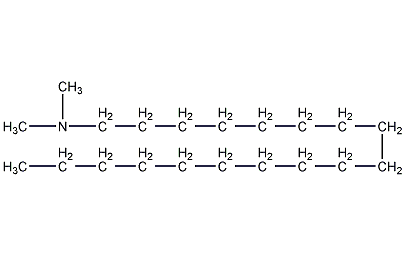
Structural formula
| Business number | 03J3 |
|---|---|
| Molecular formula | C20H43N |
| Molecular weight | 297.56 |
| label |
Octadecyldimethyltertiary amine, N,N-dimethyl-1-octadecylamine, N,N-Dimethyloctadecylamine, N,N-Dimethyloctadecylamine, Octadeca tertiary amine, linear compound |
Numbering system
CAS number:124-28-7
MDL number:MFCD00048496
EINECS number:None
RTECS number:None
BRN number:None
PubChem ID:None
Physical property data
1. Properties: light brown viscous liquid, light straw yellow soft solid at 20℃
2. Melting point (℃): 22.5
3. Boiling point (℃) : 202
4. Relative density: 0.84
5. Solubility: easily soluble in alcohol solvents, insoluble in water
6. Freezing point (℃) :22.89
Toxicological data
Skin/eye irritation: Standard Dresser test
Rabbit skin contact, 20mg/24HREACTION SEVERITY, moderate reaction;
Rabbit eye contact, 20mg/24HREACTION SEVERITY, strong reaction Reaction;
Acute toxicity data: rat intraperitoneal LDLo: 100mg/kg; mouse intraperitoneal LD50: 315mg/kg
Ecological data
None
Molecular structure data
1. Molar refractive index: 98.42
2. Molar volume (cm3/mol): 365.9
3. Isotonic specific volume (90.2K): 853.5
4. Surface tension (dyne/cm): 29.6
5. Polarizability (10-24cm3): 39.01
Compute chemical data
1. Reference value for hydrophobic parameter calculation (XlogP): None
2. Number of hydrogen bond donors: 0
3. Number of hydrogen bond acceptors: 1
4. Number of rotatable chemical bonds: 17
5. Number of tautomers: none
6. Topological molecule polar surface area 3.2
7. Number of heavy atoms: 21
8. Surface charge: 0
9. Complexity: 177
10. Number of isotope atoms: 0
11. Determine the number of atomic stereocenters: 0
12. Uncertain number of atomic stereocenters: 0
13. Determine the number of chemical bond stereocenters: 0
14. Number of uncertain chemical bond stereocenters: 0
15. Number of covalent bond units: 1
Properties and stability
1. Basic properties: It can react with ethylene oxide, dimethyl sulfate, diethyl sulfate, methyl chloride, benzyl chloride, etc. to generate different quaternary ammonium salt cations.
2.This product has low toxicity.
Storage method
Packed in plastic barrels, 50kg per barrel. Store in a cool, ventilated place. Keep away from fire and heat sources.
Packed in plastic barrels, 50kg per barrel. During long-distance transportation, wooden crates are used and the bottom of the barrel is lined with straw.
Synthesis method
Brief description of production method: It is produced by condensation of octadecylamine, formaldehyde and formic acid. First add octadecylamine into the reactor, stir evenly in the ethanol medium, control the temperature at 50-60°C, add formic acid, stir for a few minutes, add formaldehyde at 60-65°C, raise the temperature to 80-83°C, and reflux for 2 hours. , neutralize with liquid alkali to make the pH value greater than 10, let it stand for layering, remove water, distill under reduced pressure to remove ethanol, and then cool it to obtain N, N-dimethyloctadecylamine. Raw material consumption quota: octadecylamine (industrial product) 917kg/t, ethanol (95%) 417kg/t, formic acid 510kg/t, formaldehyde (37%) 546kg/t. In addition, there are methods of synthesis directly from higher alcohols and dimethylamine. Use stearyl alcohol and dimethylamine in the presence of a catalyst to perform catalytic amination in the liquid phase at 180-220°C to remove a molecule of water to obtain crude tertiary amine, which can be distilled under reduced pressure to obtain high-purity N, N -Dimethyloctadecylamine. Each ton of product consumes 971kg of stearyl alcohol and 170kg of dimethylamine.
Purpose
This product is an important organic synthesis intermediate for the preparation of quaternary ammonium salt type cationic surfactants. It can react with ethylene oxide, dimethyl sulfate, diethyl sulfate, methyl chloride, benzyl chloride, etc. to produce different quaternary ammonium salt cationic surfactants, which can be used as fabric softeners, antistatic agents, hair combing improvement agents, etc. product. It can also be used to produce insect repellents.

 微信扫一扫打赏
微信扫一扫打赏

